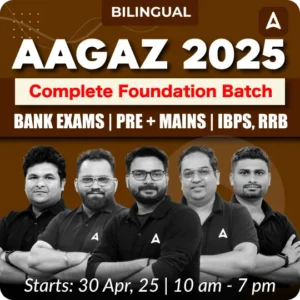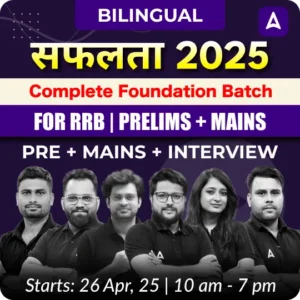The Quantitative Aptitude section in the IBPS RRB exam assesses candidates’ mathematical skills and numerical ability. The questions test not only the candidate’s computational skills but also their ability to solve problems to enhance their chances of success in the IBPS RRB Exam, as it forms a substantial part of the overall scoring. This section includes topics such as arithmetic, data interpretation, quadratic equations, number series, etc. Mastery of these topics is crucial to score well in exams.
IBPS RRB Quantitative Aptitude Questions
Directions (01-05): Read the passage given below and answer the following questions.
Three products are available on a shop – Pastry, Patty & Cake. Ratio of number of people who bought only Cake, only Pastry & only Patty is 5:8:4 respectively. People who bought both Cake and Pastry but not Patty are 50% of people who bought both Pastry and Patty but not Cake. People who bought both Cake and Patty but not Pastry are 50% more than people who bought both Cake and Pastry but not Patty. People who bought all three products together are 10% of people who bought only Cake. Total number of people who bought Cake is 800 and total number of people who bought Patty is 800.
Q01. Find total number of people who bought both Cake and Pastry.
(a) 100
(b) 150
(c) 120
(d) 90
(e) 80
Q02. People who bought both Pastry and Patty but not Cake are what percent of people who bought only Cake?
(a) 50%
(b) 30%
(c) 20%
(d) 40%
(e) 60%
Q03. Find total number of people who bought only Pastry are how much more than number of people who bought both Cake and Patty but not Pastry.
(a) 650
(b) 670
(c) 750
(d) 720
(e) 690
Q04. Find total number of people who bought Pastry.
(a) 1050
(b) 1100
(c) 1150
(d) 1000
(e) 1200
Q05. Find total number of people who bought at least two products.
(a) 520
(b) 580
(c) 550
(d) 460
(e) 500
Directions (06-10): Solve the given quadratic equations and mark the correct option based on your answer.
(a) x > y
(b) x ≥ y
(c) x < y
(d) x ≤ y
(e) x = y or no relation can be established between x and y.
Q06. I. x² + x – 12 = 0
II. y² + 2y-15 = 0
Q07. I. 6x² – 5x + 1 = 0
II. 3y² + 8y = 3
Q08. I. 12x² – 7x + 1 = 0
II. 6y² – 5y + 1 = 0
Q09. I. x² + 7x + 10 = 0
II. 2y² + 5y + 2 = 0
Q10. I. x² – 2x = 15
II. y² + 5y + 4 = 0
Q11. Average of four numbers is 64. If 3 is added to first number, multiplied to second, subtracted from the third and divided to last one then all the values are same. Find the difference between 2nd highest and the smallest number?
(a) 45
(b) 35
(c) 42
(d) 39
(e) 32
Q12. A container is full of mixture (40% water) of milk and water. A part of this mixture is replaced by another containing 81% milk and now the percentage of milk was found to be 74%. Find quantity of mixture replaced.
(a)1/3
(b)2/3
(c)2/5
(d)3/5
(e) None of these
Q13. 3 years ago, ratio of age of A and B is 3:1. If the present age of B is of the present age of A then what is the difference between their present ages (in years)?
(a) 25
(b) 30
(c) 35
(d) 40
(e) 45
Q14. A, B and C started a business by investing in the ratio of 3 : 4 : 5. After 3 months, A withdrew an amount which is equal to of total amount invested by B and C together. If A got Rs. 702 at end of year, then find the difference between the profit share of B and C?
(a) Rs. 280
(b) None of these
(c) Rs. 320
(d) Rs. 240
(e) Rs. 300
Q15. Find the probability of 7 letters word that can be formed from the letters of the word ‘CASTING’ so that vowels always come together.
(a)2/7
(b)19/42
(c)4/15
(d)10/21
(e)4/14
Directions (16-20): Study the charts given below and answer the following questions.
The given bar chart shows percentage of students in two sections A & B who have scored different range of marks in an exam.

Note:
(i) Total number of students who have appeared in exam from section A & B is 200 & 150 respectively
(ii) Marks obtained less than 35% will be considered as failed.
Q16. Find the difference between number of students failed in both the sections?
(a) 30
(b) 25
(c) 28
(d) 35
(e) 40
Q17. Find the total number of students in both the sections who have scored at least 50% but not 60% or more?
(a) 60
(b) 75
(c) 50
(d) 80
(e) 70
Q18. Number of students who have scored less than 60% in section A is what percent of students who have scored less than 80% in section B?
(a) 91
(b) 93
(c) 80%
(d) 77
(e) 88%
Q19. Students who have scored 35% or more but less than 80% are what percent of total students in both the sections?
(a) 69
(b) 70%
(c) 71
(d) 73%
(e) 75
Q20. There are total 280 students in section A and 220 students in sections B. If 3 out of every 4 students who did not appear in exam from Section A can pass the exam & 6 out of every 7 students can pass the exam from section B then find the total possible number of failed students in both sections? (if all students have appeared in exam).
(a) 85
(b) 90
(c) 88
(d) 82
(e) 93
Directions (21-25): Find the wrong number in the following number series:
Q21. 5, 7, 18, 63, 268, 1365, 8226
(a) 7
(b) 5
(c) 18
(d) 63
(e) 268
Q22. 136, 148, 168, 198, 240, 296, 366
(a) 136
(b)148
(c) 198
(d) 240
(e) 366
Q23. 268, 280, 294, 311, 333, 361, 402
(a) 311
(b) 361
(c) 402
(d) 280
(e) 294
Q24. 540, 515, 504, 492, 474, 438, 348
(a) 540
(b) 515
(c) 492
(d) 474
(e) 348
Q25. 292, 291, 295, 268, 284, 161, 195
(a) 292
(b) 284
(c) 291
(d) 268
(e) 161
Direction (26–30): The given graph shows the number of students studying in three different classes (Class VI, Class VII & Class VIII) of six different schools. Read the information carefully and answer the following questions.

Q26. Total number of students in school D in all three classes are what percent of total number of students in all three classes in school F?
(a) 40%
(b) 50%
(c) 60%
(d) 75%
(e) 100%
Q27. Total number of class VI students in school A, B & C together is how much more or less than the total number of class VIII students in school D, E & B together?
(a) 40
(b) 50
(c) 30
(d) 80
(e) 60
Q28. Find the average number of class VII students in all the schools except F.
(a) 36
(b) 32
(c) 30
(d) 38
(e) 40
Q29. Find the ratio of total number of students in school A to total number of class VIII students in school C, D & E together.
(a) 3 : 4
(b)1:1
(c) 2 : 3
(d) 3 : 2
(e) 4 : 3
Q30. Which of the following schools has highest number of students studying in these three classes?
(a) A
(b) B
(c) C
(d) D
(e) All of the above
Directions (31-35): What will come in place of (?) in the following questions?
Q31. 1620 ÷ 45 + 8836 ÷ (47)^2 = ?
(a) 50
(b) 42
(c) 48
(d) 40
(e) 45
Q32. (12)^2 + (29)^2 – {(425 + 655) ÷ (6)^3} = ?
(a) 1030
(b) 980
(c) 1065
(d) 1090
(e) 1025
Q33. 3875 ÷ (5)^3 = ? – {(24)^2 ÷ 48}
(a) 45
(b) 49
(c) 41
(d) 47
(e) 43
Q34. ![]()
(a) 662
(b) 735
(c) 679
(d) 701
(e) 726
Q35. (? ÷ 18) x 6 = 320% of 60
(a) 560
(b) 568
(c) 554
(d) 576
(e) 578
Q36. Anurag can complete a piece of work in 280 days and Rohit is 33 more efficient than Anurag. Anurag and Veer together can complete the same piece of work in 180 days. If all three-start working together, then find in how many days the work will be completed?
(a) 116 days
(b) 138 days
(c) 134 days
(d) 102 days
(e) None of the above.
Q37. Anurag can cover a km in 10 minutes and Dharam can cover a km in 15 minutes. If they both participated in a race and Anurag defeated Dharam by 200m, then find the length of race.
(a) 500m
(b) 600m
(c) 800m
(d) 400m
(e) 300m
Q38. Cost price of 10 articles is equal to marked price of 8 articles and when shopkeeper sells an article at 20% discount then he earns Rs.48 less than the amount he earned when he sells an article at 12% discount. Find cost price of the article.
(a) Rs.560
(b) Rs.540
(c) Rs.420
(d) Rs.480
(e) Rs.500
Q39. Ramesh purchased 4kg rice & 5 kg wheat for Rs.180 and Suresh purchased 2kg rice & 15kg wheat for Rs.290. Then, find per kg price of wheat is what percent of per kg price of rice?
(a) 64%
(b) 90%
(c) 75%
(d) 82%
(e) 60%
Q40. A spherical ball is melted to form 63 identical cylindrical vessels. If radius of each cylindrical vessel is of radius of spherical ball and height of each cylindrical vessel is 3cm less than radius of each cylindrical vessel, then find radius of spherical ball.
(a) 21cm
(b) 14cm
(c) 35cm
(d) 49cm
(e) 42cm
Directions (41-45): Find what will come in place of (?) in the following number series.
Q41. 987, 987, 980, 972, 909, ?
(a) 875
(b) 890
(c) 885
(d) 895
(e) 880
Q42. 564, 142, 73, 76, 156, ?
(a) 659
(b) 669
(c) 639
(d) 629
(e) 649
Q43. 842, 824, 788, 734, 662, ?
(a) 572
(b) 571
(c) 569
(d) 568
(e) 570
Q44. 11, 12, 26, 81, 328, ?
(a) 1465
(b) 1555
(c) 1765
(d) 1645
(e) 1865
Q45. 5, 7, 17, 56, 231, ?
(a) 1166
(b) 1176
(c) 1146
(d) 1136
(e) 1156
Q46. A shopkeeper earns profit of 16 after selling a book at 12.5% discount on the printed price. Then, find the ratio of the cost price & printed price of the book?
(a) 1 : 2
(b) 2 : 3
(c) 3 : 4
(d) 4 : 5
(e) 5 : 6
Q47. A container contains two liquids A and B in the ratio 8 : 5 .When 13 liters of mixture is drawn off and is completely replaced with liquid B, then the ratio of A and B in the container becomes 1 : 1. How many liter of liquid A was in the container initially ?
(a) 128/3 liter
(b) 117 liter
(c) 134/3 liter
(d) 121/3 liter
(e) 130 liter
Q48. A cricketer had a certain average of runs in 80 innings. In his 81st inning, he is bowled out for no score, due to which his average falls by 1 run. Then, find his new average of runs?
(a) 50
(b) 60
(c) 70
(d) 80
(e) 90
Q49. Vikash and Mohit started from point A towards point Q. Distance between A and Q is 9 km. If Mohit starts after 4 min., then he will meet Vikash 1 km away from point Q at a time when Vikash is returning towards point A after reaching point Q and Vikash can cover 1 km in 6 min. find speed of Mohit in km/min.
(a) 1/7
(b) 1/8
(c) 1/9
(d) 1/6
(e) 1/12
Q50. A Boat is moving in downstream and speed of Boat in still water is 5 times speed of current. After 16 km due to technical problem speed of boat (in still water) reduced by 20 % and it cover 40 km distance with this speed. If average speed of whole journey is km/min, then find speed of current.
(a) 4 1/8 km/hr
(b) 2 7/10 km/hr
(c) 4 km/hr
(d) 5 km/hr
(e) 4 3/8 km/hr
Direction (51-55): Line graph given below shows percentage of students who like PUBG in five different colleges and table shows difference between students who like PUBG and ‘Counter strike’ in these five colleges. Each of the students in these colleges likes only one of these two games. Read the data carefully and answer the question.
NOTE-: Students in each college either like PUBG or Counter Strike

| Colleges | Difference between students who like PUBG and ‘Counter strike’ |
| P | 400 |
| Q | 180 |
| R | 672 |
| S | 720 |
| T | 1440 |
Q51. Find total number of students in the colleges P & T together?
(a) 5600
(b) 5400
(c) 5200
(d) 5000
(e) 4800
Q52. Total students who like ‘Counter strike’ in Q are what percent less than total students who like same game in R?
(a) 23
(b) 23
(c) 25
(d) 27
(e) None of these
Q53. Find average number of students in R, S & T?
(a) 2800
(b) 3200
(c) 3600
(d) 3000
(e) 3400
Q54. Find the ratio of students who like PUBG in P to that of in T?
(a) 10 : 23
(b) 10 : 19
(c) 10 : 17
(d) 10 : 13
(e) 10 : 21
Q55. Total students in P & Q together are what percent more than total students in S?
(a) 12 1/2 %
(b) 14%
(c) 16 2/3 %
(d) 16 1/3 %
(e) 15%
Directions (56-60): In each of the following questions two equations are given. Solve these equations and give answer:
(a) if x ≥ y, i.e. x is greater than or equal to y
(b) if x > y, i.e. x is greater than y
(c) if x ≤ y, i.e. x is less than or equal to y
(d) if x < y, i.e. x is less than y
(e) or no relation can be established between x and y
Q56. I. 6x² + 17x + 5 = 0
II. 2y² + 21y + 49 = 0
Q57. I. x² – 8x + 15 =0
II. 2y² – 5y – 3 = 0
Q58. I. 5x² + 11x + 2 = 0
II. 4y² + 13y + 3 = 0
Q59. I. 4x + 2y = 4
II. 3x + 5y = 3
Q60. I. 6x² + x- 15 =0
II. 4y² – 24y + 35 = 0
| Solutions | |||||||||
| 1 | 2 | 3 | 4 | 5 | 6 | 7 | 8 | 9 | 10 |
|---|---|---|---|---|---|---|---|---|---|
| b | d | a | c | e | e | b | d | d | e |
| 11 | 12 | 13 | 14 | 15 | 16 | 17 | 18 | 19 | 20 |
| b | b | b | b | a | b | a | e | c | a |
| 21 | 22 | 23 | 24 | 25 | 26 | 27 | 28 | 29 | 30 |
| b | e | b | b | e | e | e | a | b | e |
| 31 | 32 | 33 | 34 | 35 | 36 | 37 | 38 | 39 | 40 |
| d | b | e | a | d | e | b | d | a | a |
| 41 | 42 | 43 | 44 | 45 | 46 | 47 | 48 | 49 | 50 |
| c | d | a | d | a | c | a | d | a | c |
| 51 | 52 | 53 | 54 | 55 | 56 | 57 | 58 | 59 | 60 |
| a | b | d | e | c | b | a | e | b | d |

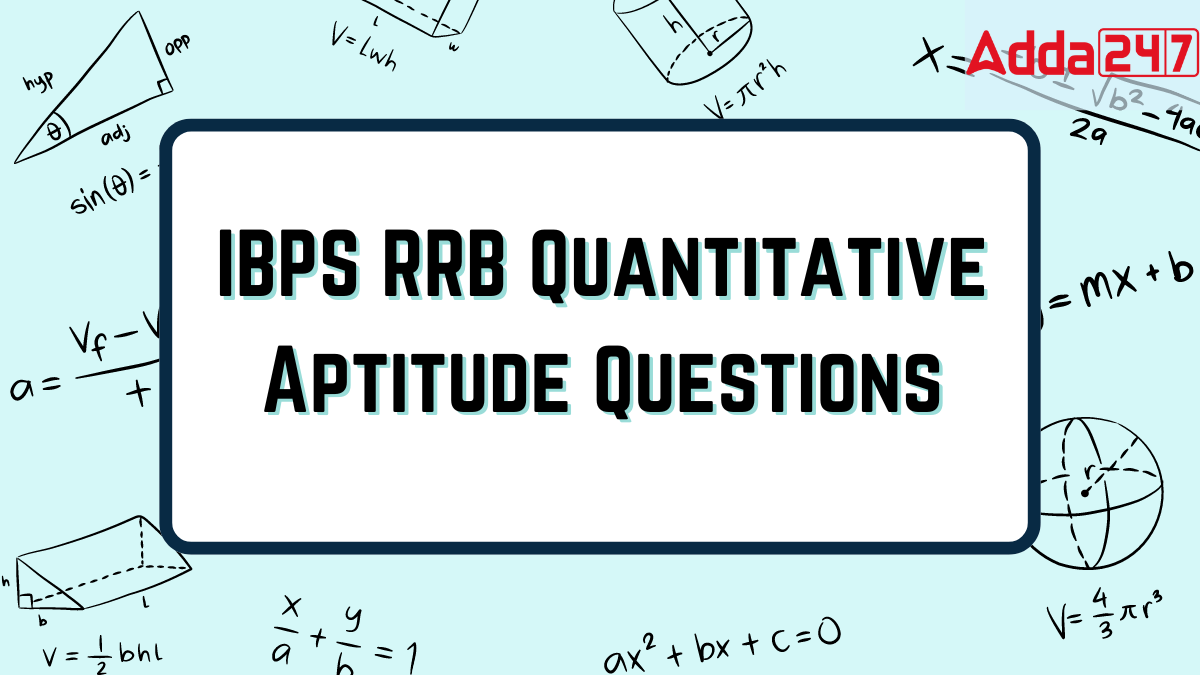
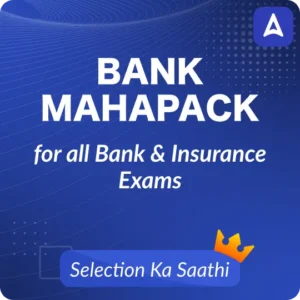


 GA Capsule for SBI Clerk Mains 2025, Dow...
GA Capsule for SBI Clerk Mains 2025, Dow...
 The Hindu Review October 2022: Download ...
The Hindu Review October 2022: Download ...
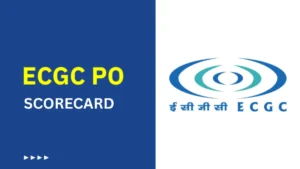 ECGC PO Scorecard 2025 Out, Check Marks
ECGC PO Scorecard 2025 Out, Check Marks

